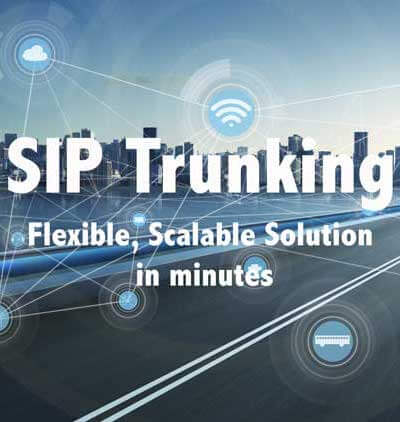The Importance of SIP Trunk Providers for Small and Medium-Sized Businesses Small and medium-sized businesses (SMBs) face unique challenges when it comes to communication. In today's fast-paced business environment, effective communication is essential for success,...
Maximizing Call Efficiency: Enhancing Call Routing with Call Flow Management Strategies, SIP Trunking and VoIP
Maximizing Call Efficiency: Enhancing Call Routing with Call Flow Management Strategies, SIP Trunking and VoIP
In today’s fast-paced business environment, maximizing call efficiency is critical to ensuring that customers receive prompt and personalized service. One key component of call efficiency is call routing, which involves directing calls to the agents or departments. Proper call routing ensures that callers are directed to the appropriate department or agent, reducing wait times and improving customer satisfaction. However, without proper call flow management strategies, call routing can become chaotic and inefficient. In this blog, we’ll discuss how call flow management can be improved with the use of VoIP or SIP trunking and benefit your business.
What is Call Flow Management?
Call flow management is the process of designing, implementing, and optimizing the flow of calls within an organization. It involves mapping out the various call paths, identifying bottlenecks and inefficiencies, and implementing strategies to streamline the call routing process. Effective call flow management can help businesses improve their customer service, reduce costs, and enhance overall efficiency.
Improving Call Routing with Call Flow Management Strategies and VoIP or SIP Trunking
Develop a Clear Call Routing Plan
Before implementing any call flow management strategies, it’s important to develop a clear call routing plan. This plan should outline the various call paths within the organization and identify which departments or agents should handle different types of calls. Unlike traditional phone systems with the use of VoIP or SIP trunking, calls can be routed across different locations, allowing businesses to have a centralized routing plan that is flexible and scalable.
To develop a call routing plan, businesses should start by identifying the different types of calls that they receive, such as sales calls, customer service calls, or technical support calls. Next, they should identify the different departments or agents that are responsible for handling each type of call. For example, sales calls might be routed to the sales department, while technical support calls might be routed to the IT department.
Once the different call paths have been identified, businesses can use VoIP or SIP trunking technology to create a centralized routing plan. This plan can be customized to meet the needs of the organization and can be adjusted as the business grows and changes.
Implement an Interactive Voice Response (IVR) System
An IVR system is an automated phone system that prompts callers to select from a series of options using their touch-tone keypad or voice recognition. VoIP or SIP trunking allows for the implementation of advanced IVR systems that can provide personalized and dynamic routing options. For example, an IVR system could prompt callers to select from options such as “Press 1 for sales, press 2 for customer service, press 3 for technical support,” and based on their selection, the call can be routed to the appropriate department or agent.
Personalized and dynamic routing options provided by IVR systems can improve the overall customer experience, reduce the amount of time that callers spend on hold or waiting for assistance, and increase customer satisfaction and loyalty. The IVR system could prompt callers to select from options that are tailored to their specific needs or preferences, or ask for important information such as their account number or a brief description of the reason for their call. This information can then be used to prioritize the call and ensure that it is routed to the most appropriate agent or department.
Use Call Queuing
Call queuing is a vital component of call center operations, ensuring that customers are not left on hold indefinitely and their calls are answered as soon as possible. With the advancements in VoIP or SIP trunking technology, call queuing can now be implemented seamlessly across different locations, allowing businesses to distribute their call volume more effectively.
When a caller is placed in a call queue, they are informed that their call will be answered shortly and that they will be placed on hold until an agent becomes available. It is essential for businesses to set realistic wait time expectations, taking into account the expected volume of calls, the number of agents available, and other relevant factors.
Besides improving the customer experience, call queuing can also benefit businesses by providing detailed call data and analytics. This data can be used to track call volumes, wait times, and other key metrics, enabling businesses to identify areas for improvement and optimize their call handling processes.
Prioritize VIP Callers
VoIP or SIP trunking technology provides businesses with the ability to implement call routing strategies that prioritize VIP customers or clients. These strategies can ensure that VIP callers receive prompt and personalized service, which can help to strengthen their loyalty and satisfaction with the business.
One common approach to prioritizing VIP callers is to provide them with a dedicated phone line. This phone line could be staffed by a team of agents who are specifically trained to handle VIP calls, or it could be routed to the most experienced and knowledgeable agents within the business. By providing VIP callers with a dedicated phone line, businesses can demonstrate their commitment to providing high-quality service and create a sense of exclusivity for these customers. Another approach to prioritizing VIP callers is to automatically route their calls to a specific agent or department. This could be based on the caller’s phone number or account information as stored in CRM system
Analyze Call Data
Regularly analyzing call data is an essential practice for businesses that use call queuing and routing strategies. This allows them to track and measure the effectiveness of their call handling processes and identify areas for improvement. With the use of VoIP or SIP trunking technology, call data can be easily collected and analyzed, providing businesses with valuable insights into their customers and call center operations.
Call data can provide valuable information such as call volumes, wait times, call durations, and the frequency of specific caller issues or inquiries. By analyzing this data, businesses can identify trends and patterns, allowing them to adjust their call routing strategies and improve the overall customer experience. For example, if call data shows that many callers are waiting for a long time before reaching an agent, businesses can adjust their routing strategies to prioritize calls and reduce wait times.
Benefits of Improving Call Routing with Call Flow Management Strategies and VoIP or SIP Trunking
Implementing effective call flow management strategies with VoIP or SIP trunking can benefit your business in several ways, including:
-
- Improved customer satisfaction: Proper call routing can reduce wait times and ensure that callers are directed to the appropriate department or agent, improving overall customer satisfaction.
- Increased efficiency: Streamlining call routing processes can reduce the time agents spend handling unnecessary calls and improve overall efficiency.
- Cost savings: With the use of VoIP or SIP trunking, businesses can reduce their communication costs by eliminating traditional phone lines and hardware expenses.
- Enhanced reporting: Analyzing call data with VoIP or SIP trunking can provide detailed insights into call volume
Why to manage a phone system
when you can get for free.
New Posts
The Importance of SIP Trunk Providers for Small and Medium-Sized Businesses
From Analog to SIP Trunking: Understanding the Evolution of Telecommunication and What It Does?
From Analog to SIP Trunking: Understanding the Evolution of Telecommunication and What It Does? Telecommunication technology has come a long way since its inception. From analog telephones to digital VoIP systems, the evolution of telecommunication has drastically...
Vanity Phone Numbers and SIP Trunking: A Winning Combination for Business Communication
Vanity Phone Numbers and SIP Trunking: A Winning Combination for Business Communication Effective communication with customers is essential for businesses to succeed in today's competitive marketplace. Vanity phone numbers and SIP trunking are two solutions that, when...
Learn more about our Products
Visit SIP Trunking Pricing to see which plan best suits your business!
Our plans have been packaged together to give you optimum output.










